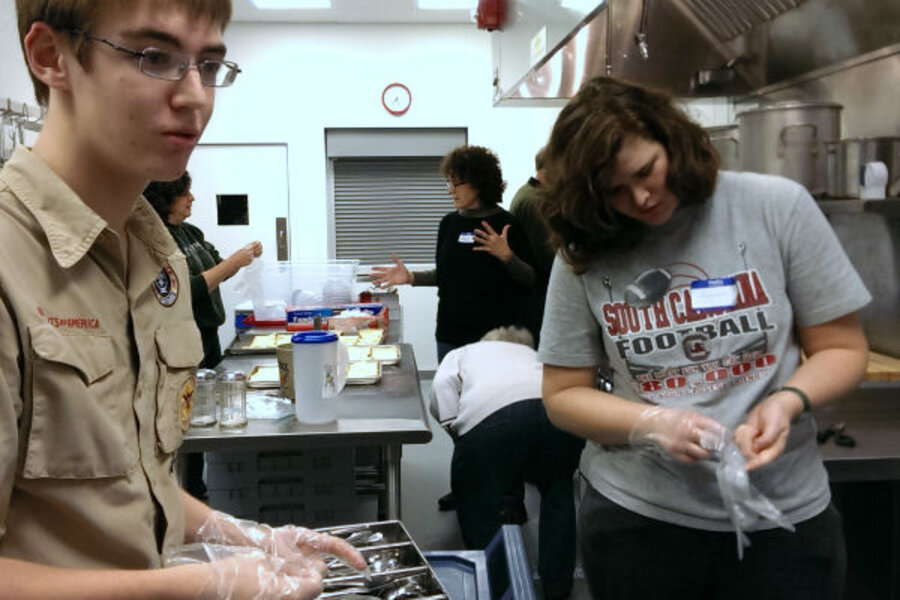Winter storm Hercules: Herculean effort to help homeless
Loading...
As winter storm Hercules takes hold of the East coast, parents have the opportunity to give older kids the mixed blessing of volunteering to help shelter and feed homeless adults, teens, and families before having to turn them back out into the storm.
This morning I woke at 4:30 a.m. after driving home to Norfolk, Va. from our first epic family trip to New York, New Jersey and D.C. with winter storm Hercules nipping at our heels.
Every fiber of my being wanted to remain in bed, but my parental conscience nagged me because I had signed everyone in the family up for shifts with the NEST (Norfolk Emergency Shelter Team).
Though still destroyed from the six hour drive the night before, I kept reminding myself, “If I bail, so will all the kids when their turn comes and I will have nobody to blame but myself.”
My husband is the one who saw the signup sheet Christmas Eve after service at our church and said, “We really need to start getting the boys to volunteer in a variety of ways.”
However, I have never done this before and so I had no idea what to expect. That’s why I took the first shift, so I could then prepare the kids before they jumped in to help.
Nothing could have prepared me for this morning’s experience of seeing a defeated, 19-year-old homeless boy waiting in line for a cold, hardboiled egg, choice of oatmeal or cold cereal, toast, and Tang or hot tea.
Our furnace quit in October and this old house is barely warm with the space heaters, even less so today with the driving wind off the Elizabeth River two houses down the street. I inwardly grumbled about this as I dressed in the dark.
On the way to the church where about 40 homeless individuals had spent the night and were soon to be awakened and summoned to a breakfast I was volunteering to help prepare and serve, a pine tree came down across the road in front of me.
It missed the nose of the minivan by two car lengths and forced me to back down the road and re-route to get to the church.
Again, one inner voice said, “It’s a sign. Just go back home to bed. No one would blame you.”
However, the mommy voice said, “No excuses. Set an example of doing the right thing to keep a promise in the scowling face of adversity.”
I then backed over a fallen branch and had to stop and crawl under the car with a flashlight in the 4:45 a.m. darkness, sleet, and wind to unstick the stick.
All the while I was thinking, “If just one of the boys grumbles about taking his shift this weekend I will have plenty of ammo.”
I was surprised to learn that the majority of the volunteers, both staying overnight and coming in at 5 a.m. for the breakfast shift, were Boy Scouts and teenagers with their families.
These kids are regulars, pros who had an entire system set up for cooking, serving, and cleaning up afterwards.
Each and every one of the volunteers treated the “guests” with dignity and respect, waiting on them, catering to requests for fresh plastic bags for belongings, and aiding one wheelchair-bound homeless man to use the restroom facilities.
As I took orders and helped the teens and others pass out toast, eggs etc. my eyes wandered across the sleeping and dining areas.
I was told that a bus was coming in an hour to collect the guests and take them downtown where they would be turned back onto the streets until tonight when the NEST shelter would re-open for the night.
The volunteer coordinator at the church explained that this is a standard practice for shelters nationwide in order to help encourage people staying in temporary shelters to seek more permanent housing and assistance from social services.
Nationally, there is a serious lack of long-term housing options. Where we live in Norfolk there is a wonderful program called ForKids, which is specifically oriented to help homeless families and children obtain long-term shelter and assistance.
While there is a sense of fulfillment that comes with serving, we must prepare our kids for the harsh reality of being powerless to do anything but watch as kids their own age walk out into the storm dished out both by Mother Nature and life.
After my experience, I took time with my sons, ages 10, 14 and 18, to explain that they will be helping homeless people who are close to their ages. I also told them that they should not fall into the trap of avoiding eye contact, especially if it turns out to be someone they know. We are making some resource sheets for teens to help them find other sources of food, shelter, and aide that the boys can slip to other kids after they have broken the ice and made some conversation.
I told the boys, “Don’t be stingy when you volunteer. While we need to be mindful of supply and demand, if you have a surplus and someone wants seconds just give it to them. If they want to stuff extra hardboiled eggs into a pocket it’s OK. This isn’t the lunch line at school. Offer a roll to go with it.”
After all my explaining I asked Avery, 14, if he was still ready to do this. He said, "Actually, now that I know more about it I'm way more comfortable about volunteering."






